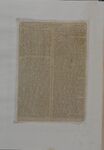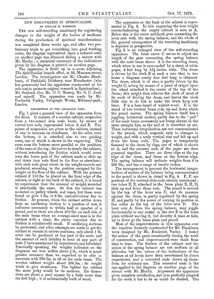New Discoveries in Spiritualism
The new self-recording machinery for registering changes in the weight of the bodies of mediums during the production of spiritual manifestations was completed three weeks ago, and after two preliminary trials to get everything into good working order, the diagram represented upon a reduced scale on another page was obtained during a stance with Mr. Haxby; a statistical summary of the indications given by the diagram is printed on another page.
The apparatus is filled up in a room adjoining The Spiritualist branch office, at 33, Museum-street, London. The investigators are Mr. Charles Blackburn, of Parkfield, Didsbury, near Manchester (who has generously had the apparatus constructed at his sole cost, to promote original research in Spiritualism); Mr. Serjeant Cox, Mr. C. C. Massey, Mr. G. C. Joad, and myself. The apparatus was made by Mr. Frederick Varley, Telegraph Works, Mildmay-park, London.
Fig. I gives a general view of the apparatus from the front. It consists of a wooden cabinet, suspended from a two-armed iron scale beam, by means of curved iron rods, represented below A and B. Two points of suspension are given to the cabinet, instead of one, to increase its steadiness. At the sides, near the bottom, it is attached also to two guiding arms, one of which is shown in the engraving. The arms near the bottom move parallel to the positions of the arms at the top; they serve to steady the cabinet, without introducing the friction which would occur were the lower part of the cabinet made to slide up and down iron rods fixed in the floor or elsewhere; with such rods great errors in the weight-records are produced, according to the position occupied by the weight on the floor of the cabinet. With the present cabinet if 150 lbs. be placed on the front edge of the cabinet, or right at the back of the cabinet, it is found by experiment that the amount of weight recorded is practically the same. At first the cabinet was mounted on pulley wheels and ropes, but these were found to give 5 lbs. or 6 lbs. insensitiveness due to friction. At present, when the cabinet settles down from an oscillating motion to a position of rest, it indicates accurately to within half or quarter of a pound, and as there are about 350 lbs. on each side of the scale beam when an average-sized man is in the cabinet with a chair, the above variation due to friction is satisfactorily small. If oscillating motions be prevented, and when attempts are made to get the cabinet to remain in untrue positions, only about 1 lb. error can be produced at any part of the scale, and the amount of such liability to error at any part of scale I have ascertained by experiment, and tabulated. Practically speaking, the weights indicated on the diagrams are true within about 1/4 lb., which is much greater accuracy than we expected to be able to ascertain with 700 lbs. in all on the scale beam. The wooden cabinet weighs about 200 lbs.; its weight tends to give steadiness. The lighter the cabinet the more jerky would be its motions. Its dimensions are about a yard square by a little more than I six feet high; it is substantially built of wood.
The apparatus at the back of the cabinet is represented in Fig. 2. In this engraving the iron weight counterbalancing the empty cabinet is seen at A. Below this is the screw and hook gear connecting the lever arm with the spring balance, and the whole of the general arrangement of the recording machinery is depicted in perspective.
Fig. 3 is an enlarged view of the self-recording apparatus. The brass screw C serves to adjust the length of the gear connecting the spring balance with the scale beam above. A is the recording drum, which when in use is surrounded by a sheet of white paper, 4 feet long by 13 1/4 inches wide. The drum is driven by the clock B at such a rate that in two hours a diagram nearly four feet long is obtained. The drum, which is of zinc, is partly driven by the weight C, acting by means of a piece of catgut upon the wheel attached to the centre of the top of the drum; this weight thus relieves the clock of most of its work of driving the drum, and leaves the clock little else to do but to make the drum keep true time. F is a base-board of walnut-wood. E is the stand of two vertical brass rods, up and down which the pencil moves. The spring balance itself has a joggling horizontal motion, partly due to the “pull” of the scale beam necessarily not being always in the same straight line, as the end of it describes an arc. These horizontal irregularities are not communicated to the pencil, which responds only to changes in weight, and with a truly vertical rise and fall up and down the brass rods. The paper is temporarily fastened to the drum by clips, one of which is shown at A, and the extreme ends of the paper are then gummed together. There are three clips at the top edge of the drum, and three at the bottom edge. The spring balance will indicate weights from 0 to 200 lbs., and has a range of twelve inches.
The arrangement to prevent the horizontal irregularities of motion of the balance being communicated to the pencil is shown in detail in Fig. 4. F, F, are portions of the vertical slide-rods already mentioned; two tubes E, E, attached to the brass plate E, H, D, slide up and down these rods. The pencil is carried by the top of the lever arm D, and its pressure against the drum is partly regulated by the spring H, and partly by the power of varying its position in the collar at the top of the lever arm D. The bent arm A, from the spring balance, may joggle horizontally to any extent in the slot B in the brass plate without moving it, but directly A rises or falls, up or down go the brass plate and pencil.
Most of the improvements in this apparatus over the machine formerly constructed for Mr. Blackburn were designed by Mr. Frederick Varley. I tested the action of the parts occasionally during the work of construction, and improvements were made from time to time. The friction of the cabinet and the action of the spring balance are not uniform at all altitudes, but the values of the indications of the balance at all levels have been ascertained by direct experiment, and a corrected scale drawn up therefrom for ordinary use. This corrected scale is the one applied to the diagram on another page of the seance with Mr. Haxby. At present the apparatus gives complete satisfaction, and is as perfectly adapted for the work it has to do as could be desired. The <... continues on page 10-73 >
Editor's notes
- ↑ New Discoveries in Spiritualism by Harrison, William H., London Spiritualist, No. 373, October 17, 1879, pp. 186-90
Sources
-
London Spiritualist, No. 373, October 17, 1879, pp. 186-90


